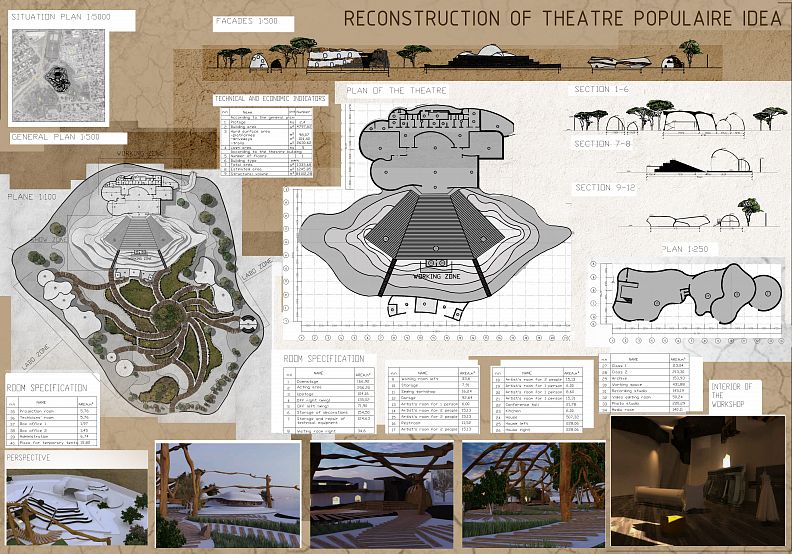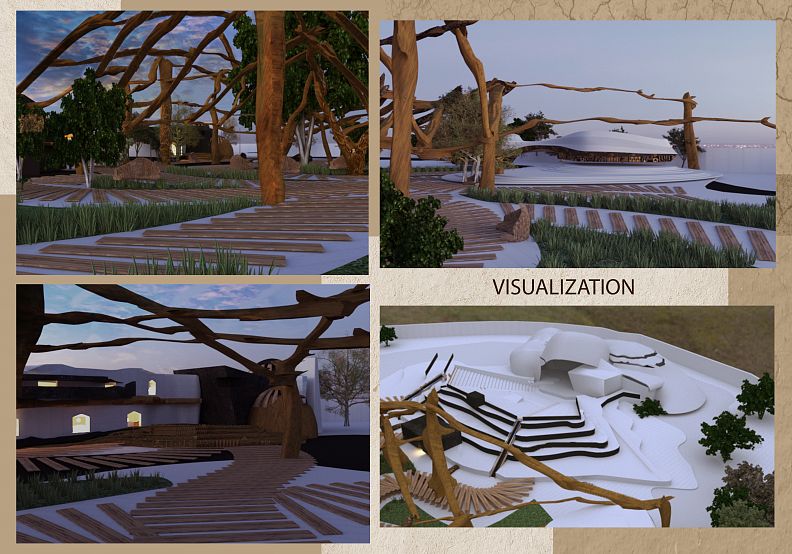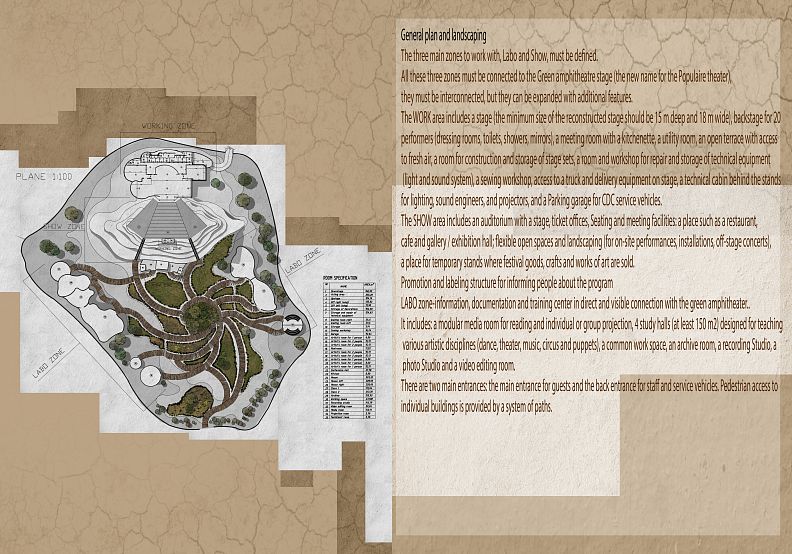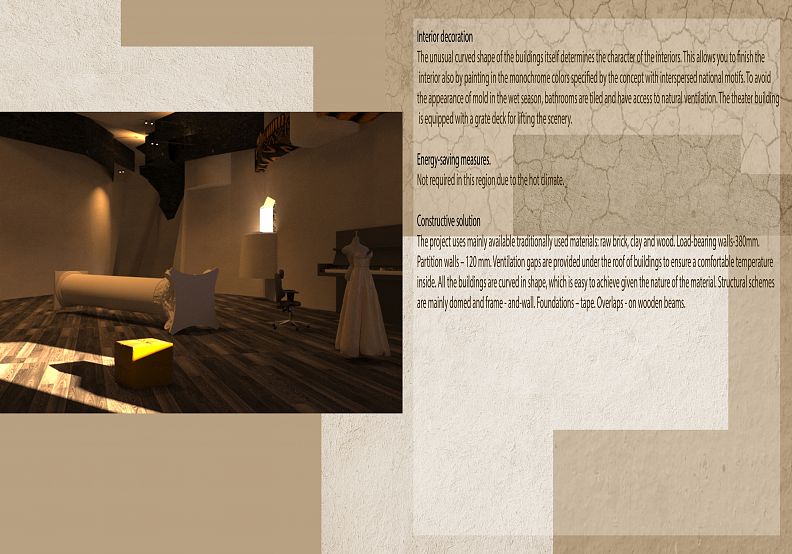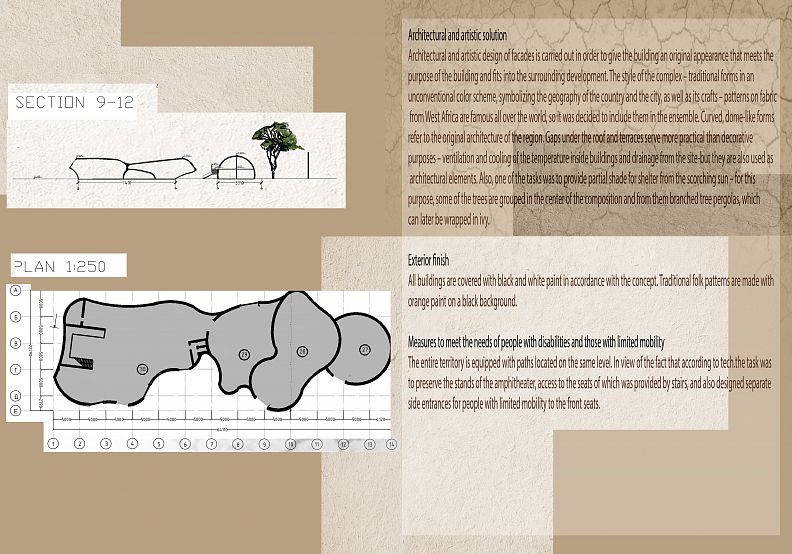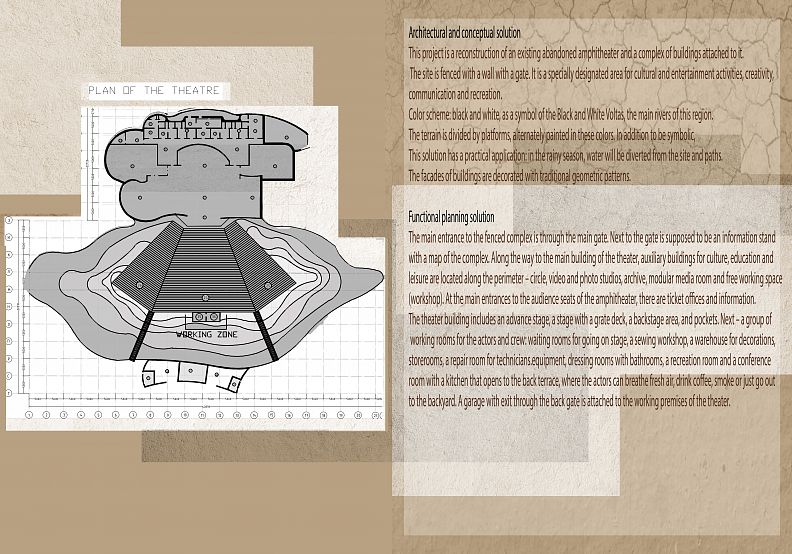Reconstruction of Theatre Populaire

Project idea
This project is a reconstruction of an existing abandoned amphitheater and a complex of buildings attached to it. The site is fenced with a wall with a gate. It is a specially designated area for cultural and entertainment activities, creativity, communication and recreation. Color scheme: black and white, as a symbol of the Black and White Voltas, the main rivers of this region. The terrain is divided by platforms, alternately painted in these colors. In addition to be symbolic, this solution has a practical application: in the rainy season, water will be diverted from the site and paths. The facades of buildings are decorated with traditional geometric patterns.
Project description
General plan and landscaping
The three main zones to work with, Labo and Show, must be defined. All these three zones must be connected to the Green amphitheatre stage (the new name for the Populaire theater), they must be interconnected, but they can be expanded with additional features.
The WORK area includes a stage (the minimum size of the reconstructed stage should be 15 m deep and 18 m wide), backstage for 20 performers (dressing rooms, toilets, showers, mirrors), a meeting room with a kitchenette, a utility room, an open terrace with access to fresh air, a room for construction and storage of stage sets, a room and workshop for repair and storage of technical equipment (light and sound system), a sewing workshop, access to a truck and delivery equipment on stage, a technical cabin behind the stands for lighting, sound engineers, and projectors, and a Parking garage for CDC service vehicles.
The SHOW area includes an auditorium with a stage, ticket offices, Seating and meeting facilities: a place such as a restaurant, cafe and gallery / exhibition hall; flexible open spaces and landscaping (for on-site performances, installations, off-stage concerts), a place for temporary stands where festival goods, crafts and works of art are sold. Promotion and labeling structure for informing people about the program
LABO zone-information, documentation and training center in direct and visible connection with the green amphitheater.. It includes: a modular media room for reading and individual or group projection, 4 study halls (at least 150 m2) designed for teaching various artistic disciplines (dance, theater, music, circus and puppets), a common work space, an archive room, a recording Studio, a photo Studio and a video editing room.
There are two main entrances: the main entrance for guests and the back entrance for staff and service vehicles. Pedestrian access to individual buildings is provided by a system of paths.
Functional planning solution
The main entrance to the fenced complex is through the main gate. Next to the gate is supposed to be an information stand with a map of the complex. Along the way to the main building of the theater, auxiliary buildings for culture, education and leisure are located along the perimeter – circle, video and photo studios, archive, modular media room and free working space (workshop). At the main entrances to the audience seats of the amphitheater, there are ticket offices and information. The theater building includes an advance stage, a stage with a grate deck, a backstage area, and pockets. Next – a group of working rooms for the actors and crew: waiting rooms for going on stage, a sewing workshop, a warehouse for decorations, storerooms, a repair room for technicians.equipment, dressing rooms with bathrooms, a recreation room and a conference room with a kitchen that opens to the back terrace, where the actors can breathe fresh air, drink coffee, smoke or just go out to the backyard. A garage with exit through the back gate is attached to the working premises of the theater.
Architectural and artistic solution
Architectural and artistic design of facades is carried out in order to give the building an original appearance that meets the purpose of the building and fits into the surrounding development. The style of the complex – traditional forms in an unconventional color scheme, symbolizing the geography of the country and the city, as well as its crafts – patterns on fabric from West Africa are famous all over the world, so it was decided to include them in the ensemble. Curved, dome-like forms refer to the original architecture of the region. Gaps under the roof and terraces serve more practical than decorative purposes – ventilation and cooling of the temperature inside buildings and drainage from the site-but they are also used as architectural elements. Also, one of the tasks was to provide partial shade for shelter from the scorching sun – for this purpose, some of the trees are grouped in the center of the composition and from them branched tree pergolas, which can later be wrapped in ivy.
Exterior
All buildings are covered with black and white paint in accordance with the concept. Traditional folk patterns are made with orange paint on a black background.
Interior decoration
The unusual curved shape of the buildings itself determines the character of the interiors. This allows you to finish the interior also by painting in the monochrome colors specified by the concept with interspersed national motifs. To avoid the appearance of mold in the wet season, bathrooms are tiled and have access to natural ventilation. The theater building is equipped with a grate deck for lifting the scenery.
Technical information
Measures to meet the needs of people with disabilities and those with limited mobility
The entire territory is equipped with paths located on the same level. In view of the fact that according to tech.the task was to preserve the stands of the amphitheater, access to the seats of which was provided by stairs, and also designed separate side entrances for people with limited mobility to the front seats.
Fire prevention measures
Fire prevention is provided by the complex spatial, structural, technical decisions that are taken on the basis of destination, category explosion and fire hazard, degree of fire resistance and height (number of storeys) of buildings, number of people evacuated.
Due to the fact that insufficient fire-resistant materials are used in local access, the number of floors in the buildings of the complex does not exceed two.
Doors of evacuation exits and doors on evacuation routes open in the direction of people leaving the building.
The minimum width of escape routes and doorways on escape routes is 1.1 m and 0.9 m, respectively.
Energy-saving measures.
Not required in this region due to the hot climate.
Constructive solution
The project uses mainly available traditionally used materials: raw brick, clay and wood. Load-bearing walls-380mm. Partition walls – 120 mm. Ventilation gaps are provided under the roof of buildings to ensure a comfortable temperature inside. All the buildings are curved in shape, which is easy to achieve given the nature of the material. Structural schemes are mainly domed and frame - and-wall. Foundations – tape. Overlaps - on wooden beams.
